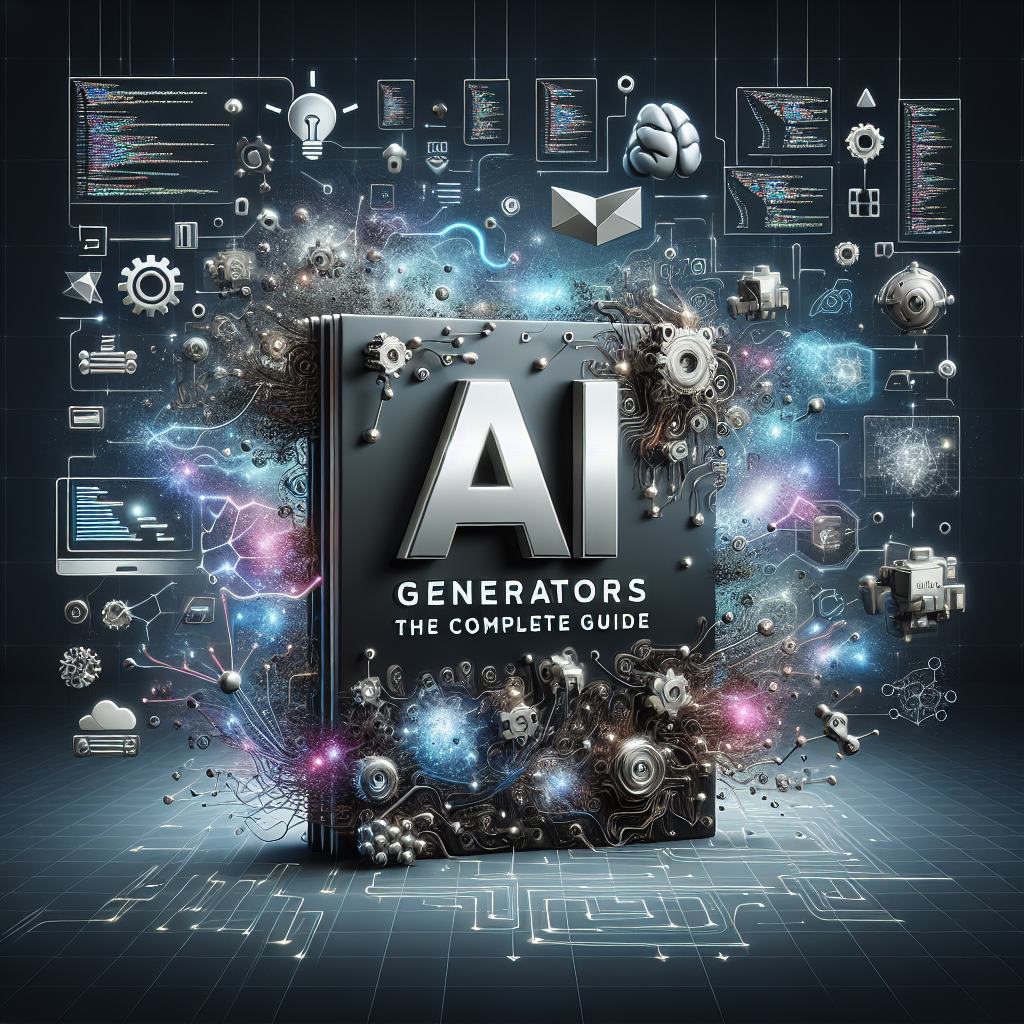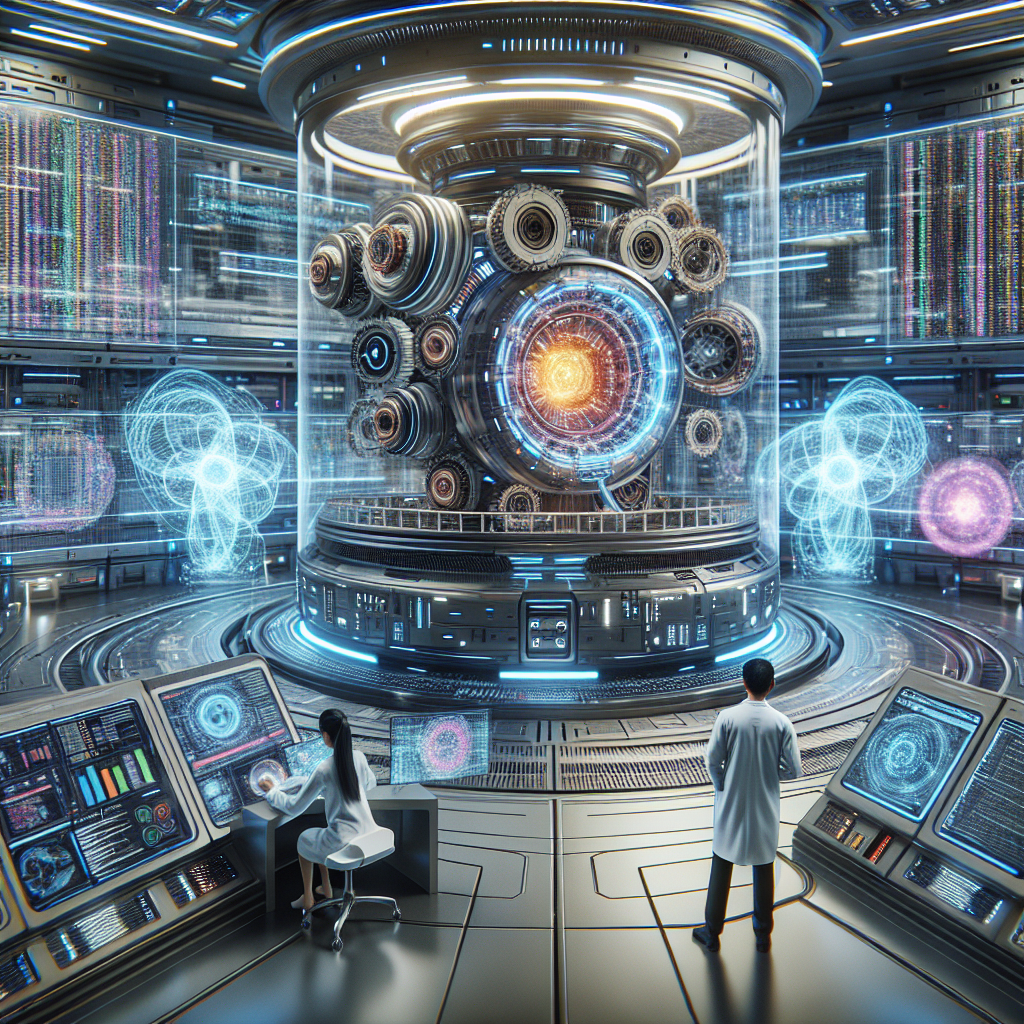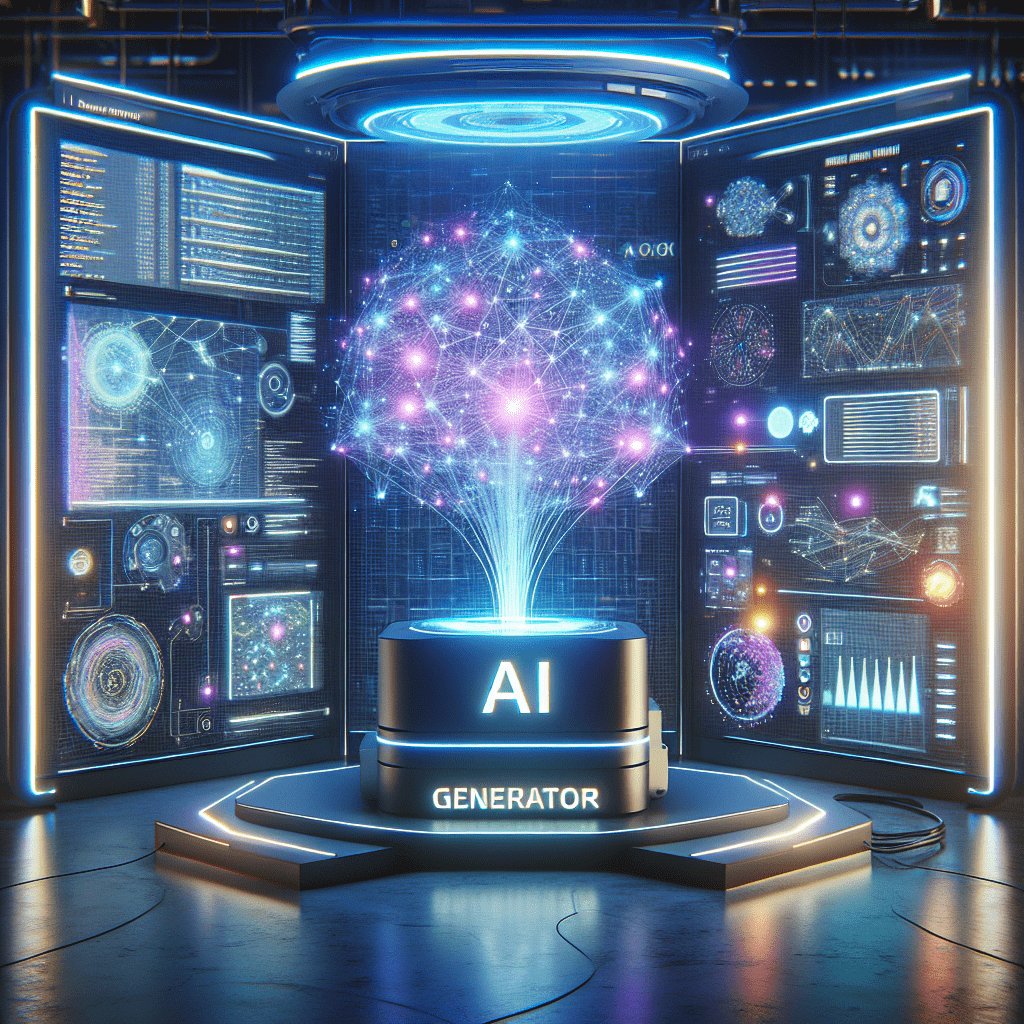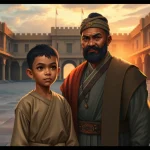The Complete Guide to AI Generators
GizAI’s AI Generators: Quick Access
- AI Video Generator
- AI Face Video
- AI Video Chat
- AI Image Generator
- AI Headshot Generator
- AI Audio Generator
- AI Voice Generator
- AI Transcription
- AI Story Generator
- AI Game Generator
- AI for News
- AI Blog Writer
- AI YouTube Summary
- AI PDF Summary
- AI Chat
Introduction to AI Generator Guide
In the rapidly evolving landscape of artificial intelligence, few developments have captured the imagination and sparked as much discussion as AI generators. These remarkable tools, capable of producing human-like text, stunning images, lifelike audio, and even coherent video content, are reshaping our understanding of creativity, productivity, and the very nature of human-machine interaction.
As we stand on the cusp of a new era in technology, AI generators are at the forefront, promising to revolutionize industries, transform creative processes, and open up new possibilities that were once the realm of science fiction. From the aspiring writer seeking inspiration to the multinational corporation looking to streamline its operations, AI generators are offering solutions that are both exciting and, at times, controversial.
This comprehensive guide aims to demystify AI generators, exploring their origins, current capabilities, and potential future developments. We’ll delve into the various types of AI generators, examine the technologies that power them, and discuss their wide-ranging applications across different sectors. Along the way, we’ll also confront the ethical challenges and limitations of these tools, providing a balanced view of their impact on society.
Whether you’re a tech enthusiast, a professional looking to leverage AI in your work, or simply curious about the future of artificial intelligence, this guide will provide you with a deep understanding of AI generators and their place in our rapidly changing world. So, let’s embark on this journey to uncover the fascinating world of AI generators and explore how they are shaping the future of human creativity and innovation.
What are AI Generator?
AI generators, also known as generative AI or GenAI, represent a groundbreaking class of artificial intelligence systems designed to create new content based on patterns and information learned from vast amounts of training data. These sophisticated tools use advanced machine learning techniques, primarily deep learning and neural networks, to understand and mimic the structure and characteristics of various types of data.
At their core, AI generators are built on the principle of learning statistical patterns and relationships within a given dataset and then using this knowledge to generate new, original content that resembles the training data in style and structure but is not a direct copy. This ability to create novel content has led to AI generators being described as “creative AI” or “artificial creativity” tools.

<Image generated with GIzAI and DALL-E: Blog cover for The Complete Guide of AI Generators.>
Type of AI Generators
AI Image Generators: From Text to Art in Seconds
AI image generators have taken the internet by storm, allowing users to create stunning visuals from simple text descriptions. Imagine typing “a majestic lion in a field of wildflowers” and watching an AI transform those words into a breathtaking digital painting. This is the power of AI image generators like:
-
DALL-E 3: Developed by OpenAI, DALL-E 3 is known for its realistic and detailed outputs, making it a favorite among artists and designers.
-
Midjourney: This AI generator excels in creating unique and artistic images, often pushing the boundaries of what’s possible with traditional art forms.
-
Stable Diffusion: A popular open-source AI image generator, Stable Diffusion offers users a high degree of control and customization, allowing for unique and creative results.
-
Adobe Firefly: Adobe’s entry into the AI image generation space, Firefly seamlessly integrates with Adobe’s creative suite, making it a powerful tool for professionals.
These AI image generators are being used for a variety of purposes:
-
Content Creation: Bloggers, social media marketers, and content creators use AI image generators to create visually appealing content that grabs attention and enhances engagement.
-
Design and Illustration: Graphic designers and illustrators are using AI image generators to explore new ideas, create concept art, and generate unique visual elements for their projects.
-
Entertainment: Games, movies, and other forms of entertainment are increasingly incorporating AI-generated visuals to create immersive and visually stunning experiences.
Beyond Images: The Rise of AI Video Generators
The capabilities of AI generators are expanding beyond images, with AI video generators now making their mark. These tools can create short videos from text prompts, allowing users to bring their creative visions to life. Some notable examples include:
-
Runway: Runway’s AI video generator has gained attention for its ability to produce high-quality, realistic videos from simple text prompts, but has also faced criticism for its training data, which allegedly includes scraped YouTube videos and pirated films.
-
Kling: This AI video generator offers multilingual support and impressive features, making it a strong contender in the growing AI video generation space.
-
OpenAI’s Sora: OpenAI’s Sora is a powerful AI video generator capable of producing cinematic-quality videos, showcasing the potential of AI to revolutionize filmmaking and visual storytelling.
The potential for AI video generators is vast, with applications in:
-
Marketing and Advertising: Businesses can use AI video generators to create engaging and shareable video content for their social media campaigns and product demos.
-
Education and Training: AI video generators can be used to create educational videos, simulations, and training materials that are engaging and informative.
-
Entertainment and Art: AI video generators are being used to create experimental films, music videos, and other forms of artistic expression, pushing the boundaries of what’s possible in visual media.
<Video generated with GIzAI and AnimateLCM: Researchers in a lab developing various AI generators.>
AI Music Generators: Composing the Future of Sound
The realm of music is also being transformed by AI generators. AI music generators can create original compositions, generate melodies, and even mimic the styles of famous musicians.
-
Udio: This AI music generator has undergone significant upgrades, offering a wider range of features and improved audio quality.
-
Amper Music: Amper Music uses AI to create custom music for various applications, including video games, commercials, and corporate presentations.
-
Jukebox: Developed by OpenAI, Jukebox is a powerful AI music generator that can create music in various genres and styles, showcasing the potential of AI to revolutionize music creation.
AI music generators have the potential to:
-
Democratize Music Creation: AI music generators can empower individuals without formal musical training to create and share their own music.
-
Expand Musical Exploration: Musicians can use AI music generators to explore new sounds, experiment with different genres, and push the boundaries of musical composition.
-
Enhance Music Production: AI music generators can assist music producers in creating backing tracks, generating sound effects, and even composing entire pieces.
Popular AI Generators 2024
Artificial Intelligence (AI) has revolutionized various industries by offering innovative tools for creativity, productivity, and automation. From generating realistic images and videos to enhancing writing and designing capabilities, AI-powered tools have become indispensable. This article categorizes some of the most popular AI generators, highlighting their unique features and applications.
AI Chat and Conversation Tools
These AI models, often based on large language models (LLMs), can produce human-like text ranging from short sentences to long-form articles. They are capable of tasks such as writing essays, generating creative fiction, answering questions, and even engaging in conversational exchanges.
-
ChatGPT: Engaging in AI conversations has never been more intuitive than with ChatGPT. This powerful language model by OpenAI offers task automation, making it an essential tool for generating insights and providing virtual assistance. Its ability to understand and generate human-like text has made it a favorite for both casual users and businesses seeking to enhance customer support and engagement.
-
Claude: Known for its AI assistant named Claude, Anthropic focuses on providing safe and accurate AI services. Claude offers capabilities in natural language processing, data analysis, and machine learning, making it a versatile assistant for both personal and professional use. Its emphasis on safety and reliability sets it apart in the AI assistant market.
-
Google Gemini: Google Gemini provides direct access to Google’s AI models on your mobile device, offering features like image recognition and text translation. This tool brings the power of Google’s AI directly to users, enabling real-time interactions and assistance in various tasks, from identifying objects in photos to translating languages on the go.
-
LLaMA3: Developed by Meta, LLaMA3 (Large Language Model Meta AI) is an advanced language model designed to facilitate natural language understanding and generation. It supports a wide range of applications, including conversational AI, content creation, and research. LLaMA3’s sophisticated algorithms enable it to generate highly accurate and contextually relevant responses, making it a valuable tool for developers and researchers.
For a detailed comparison of large language models and providers, visit Artificial Analysis. This site offers essential benchmarks and insights.
AI Image Generators
Capable of creating, editing, or manipulating visual content, these AI tools can generate realistic images from textual descriptions or modify existing images. They have applications in areas such as digital art creation, product design, and visual effects for entertainment.
-
DALL-E 3: Developed by OpenAI, DALL-E 3 is known for its ability to generate highly detailed and photorealistic images from text prompts. It has advanced features that integrate text within images seamlessly, making it a powerful tool for professional and creative projects
-
Stable Diffusion: Stable Diffusion is an open-source AI model that excels at generating high-quality images from text prompts, offering a wide range of styles from photorealistic to abstract. Stable Diffusion XL (SDXL) builds upon this by providing higher resolution images and improved detail, making it ideal for professional applications that require greater image fidelity. Stable Diffusion 3 (SD3) further enhances these capabilities with advanced diffusion transformer architecture and flow matching technology, resulting in superior multi-subject handling and text integration within images. SD3 is available through Stability AI’s API and platforms like Hugging Face, making it accessible for both personal and commercial use.
-
Midjourney: As a research lab dedicated to expanding human imagination, Midjourney is known for its AI art generator. It enables users to create stunning visual designs and artworks, pushing the boundaries of creativity with its advanced AI infrastructure.
-
Civitai: Civitai specializes in AI-generated imagery with a focus on the Stable Diffusion model technology. It offers a wide range of models for creating and sharing digital art. Users can explore over 1700 models, including those for specific artistic styles, characters, and more. Civitai provides features like LoRA networks for style adjustment and Diffuser weights for altering image clarity. The platform is free and open-source, promoting a supportive community for AI art enthusiasts.
-
NightCafe Creator: NightCafe Creator is an app that allows users to generate beautiful AI art. With tools like Stable Diffusion and Neural Style Transfer, it offers a community-driven platform for artists to explore and share their creations.
-
Artbreeder: Artbreeder allows users to blend and create images through a unique “breeding” system. Users can merge multiple images to generate new, unique artwork. It provides various pricing plans to suit different needs and is popular for its genetic crossing approach, which results in diverse and creative outputs.
-
DeepAI: DeepAI specializes in style transfer, transforming ordinary photos into artwork based on the styles of famous painters or unique patterns. It is ideal for those looking to create stylized art from their images, offering a simple yet powerful tool for artistic expression.
AI Video Generators
Emerging technologies in this field can generate short video clips or animations based on text prompts or existing footage. While still in early stages compared to other types of generators, they show promise for revolutionizing video content creation.
-
Sora: Sora is an AI model designed to create scenes from text, perfect for video creation and storytelling. It transforms written descriptions into vivid visual content, making it a valuable tool for content creators and marketers aiming to bring their narratives to life. Not yet available to the public.
-
Luma Dream Machine: This AI video generator excels in creating vivid video content with cinematic motion and character consistency. It’s designed for fast iteration and universal access, making it ideal for filmmakers and video creators seeking to produce high-quality visuals efficiently.
-
Luma AI: Luma AI enables lifelike 3D capture and photorealistic effects, offering tools for creating detailed 3D models and scenes. Its technology is widely used in augmented reality (AR), virtual reality (VR), and various creative projects.
Audio Generators
These tools leverage advanced AI to convert text to speech, generate music, and create realistic audio content. They are widely used for applications such as audiobooks, podcasts, music creation, and accessibility, offering a range of voices and styles to suit different needs.
-
ElevenLabs: Known for its highly realistic and human-like voices, ElevenLabs offers both text-to-speech and speech-to-speech capabilities. It supports over 40 pre-made AI voices and has a community library with thousands of voices. The platform also allows for custom voice creation and automatic dubbing in multiple languages, making it ideal for podcasts, audiobooks, and more
-
Speechify: This tool transforms text from various formats into natural-sounding speech. It supports over 200 voices in 20+ languages and accents, making it an excellent choice for listening to written content on the go or for accessibility purposes. Speechify also allows granular control over pitch, tone, and speed
-
Suno is an AI-driven platform designed to create personalized music and lyrics based on user prompts. It caters to a wide range of users, including content creators and marketers, providing quick and customizable music generation.
-
Udio is often referred to as the “ChatGPT for music” due to its accessibility and high-quality music production capabilities. Developed by former Google DeepMind researchers, Udio aims to democratize music creation, making it accessible to everyone.
AI Writing and Content Tools
These tools utilize AI to assist with writing, editing, and content creation. They enhance productivity by providing grammar checks, plagiarism detection, paraphrasing, and content suggestions, making them invaluable for students, professionals, and content creators.
-
Notion: Notion integrates wiki, docs, and project management into a single workspace, making it a versatile tool for team collaboration and knowledge management. Its AI-powered features enhance productivity and streamline workflows, making it a go-to platform for businesses and individuals alike.
-
Grammarly: Grammarly provides AI writing assistance to enhance writing skills and communication. With tools for grammar checking, plagiarism detection, and citation generation, it is an essential companion for students, professionals, and anyone looking to improve their writing.
-
Quillbot: Quillbot is an online tool for rewriting text, offering features like paraphrasing, academic writing assistance, and content creation. It helps users refine their writing by providing suggestions for better phrasing and clarity.
AI Design and Creativity Tools
These AI-powered tools enhance creative processes, from graphic design and video editing to marketing and document management. They simplify complex tasks, making it easier for users to produce professional-quality content and streamline their workflows.
-
Adobe: Adobe remains a leading company in providing creative, marketing, and document management solutions. Its suite of software tools, including Photoshop and Illustrator, incorporates AI to enhance graphic design, digital marketing, and document editing, making it a staple for creatives.
-
Canva: Canva is an online design tool that simplifies the creation of stunning graphics and presentations. With its AI-powered features, users can easily design social media posts, marketing materials, and more, even without prior design experience.
-
Wondershare: Wondershare offers a range of AI-powered tools for creativity, productivity, and utility solutions. From video editing and media conversion to diagramming and PDF editing, its software suite caters to various needs, helping users streamline their projects and workflows.
These AI generators represent the forefront of technology, enhancing creativity, productivity, and efficiency. Whether you aim to create stunning visuals, improve your writing, or streamline workflows, these tools offer the capabilities you need.
For a comprehensive directory and detailed information on over 9,100 AI tools across 233 categories, along with user-friendly features and easy integration, refer to Toolify AI to streamline your search and implementation process.
Free AI Generator 2024
The world of artificial intelligence is constantly evolving, and one of the most exciting developments is the rise of AI image generators. These powerful tools allow anyone to create stunning visuals from simple text prompts, opening up a world of creative possibilities.
But with so many options available, it can be overwhelming to find the best free AI image generator for your needs. That’s where this comprehensive guide comes in. We’ll explore the top free AI image generators, their unique features, and how you can use them to bring your ideas to life.
Why Choose a Free AI Image Generator?
Before diving into the specifics, let’s address the elephant in the room: why choose a free AI image generator when paid options exist?
-
Experimentation: Free AI image generators are perfect for experimenting with different prompts, styles, and techniques without any financial commitment.
-
Budget-Friendly: For individuals or small businesses on a tight budget, free AI image generators provide a cost-effective way to create high-quality visuals.
-
Accessibility: Free options make AI image generation accessible to everyone, regardless of their technical expertise or financial resources.
Top Free AI Image Generators to Try:
Now, let’s explore some of the most popular and powerful free AI image generators available today:
1. Canva’s AI Image Generator:
Canva, known for its intuitive design platform, offers a powerful AI image generator that’s incredibly user-friendly. With Canva’s free plan, you get 50 lifetime uses, allowing you to experiment with different prompts and styles. For more advanced users, Canva Pro offers unlimited image generation.
Key Features:
-
Intuitive interface: Canva’s familiar design interface makes it easy to navigate and generate images.
-
Diverse styles: Choose from a wide range of styles, including realistic, abstract, artistic, and more.
-
Integration with Canva: Seamlessly incorporate your AI-generated images into Canva’s design projects.
2. Microsoft Designer’s Image Creator:
Microsoft Designer, a free online design tool, integrates OpenAI’s DALL-E 3 for its image generator, making it a powerful and versatile option.
Key Features:
-
Powered by DALL-E 3: Access the cutting-edge AI technology behind DALL-E 3 for high-quality image generation.
-
Text-to-image and image-to-image: Create images from text prompts or modify existing images with AI.
-
Free to use: No limitations on the number of images you can generate.
3. DeepAI’s Text2Img:
DeepAI is a leading provider of free AI tools, and their Text2Img generator is a popular choice for creating images from text.
Key Features:
-
Multiple models: Choose from different AI models to achieve different styles and results.
-
Simple interface: A straightforward interface makes it easy to generate images with just a few clicks.
-
Customizable settings: Adjust various parameters to fine-tune your image generation.
4. Craiyon (formerly DALL-E mini):
Craiyon (formerly DALL-E mini) gained popularity for its accessibility and ease of use. While its image quality may not match the more advanced options, it’s a fun and free tool for experimenting with AI image generation.
Key Features:
-
No sign-up required: Start generating images instantly without creating an account.
-
Simple interface: A basic interface with a single text input field makes it easy to use.
-
Free for all: No limitations on the number of images you can generate.
5. NightCafe Creator:
NightCafe Creator is a free AI art generator that offers a range of artistic styles and features. It’s a great choice for creating unique and abstract artwork.
Key Features:
-
Artistic styles: Generate images in various artistic styles, including surrealism, impressionism, and more.
-
Community features: Share your creations with other artists and explore a wide range of AI art.
-
Free and paid options: Start with a free plan or upgrade for more advanced features.
Beyond Free Options: Exploring Paid Alternatives
While free AI image generators offer excellent starting points, paid options often provide enhanced features and capabilities. Here are some popular paid alternatives to consider:
-
DALL-E 2: OpenAI’s DALL-E 2 is widely considered the gold standard in AI image generation, offering exceptional realism and artistic detail.
-
Midjourney: Midjourney is a powerful AI art generator known for its unique and often abstract results.
-
Stable Diffusion: Stable Diffusion is an open-source AI image generator that offers a high degree of customization and control.
Tips for Generating High-Quality Images:
-
Write clear and descriptive prompts: The more specific and detailed your prompt, the better the AI will understand your vision.
-
Use keywords and adjectives: Include keywords that describe the subject, style, and mood of your desired image.
-
Experiment with different styles: Don’t be afraid to try different styles and see what results you get.
-
Refine your prompts: If the initial results aren’t quite what you had in mind, adjust your prompt and try again.
-
Use image-to-image generation: If you have a starting image, use image-to-image generation to modify it with AI.
Key Characteristics of AI Generators
-
Data-driven learning: AI generators require large datasets to train on, learning patterns and features from existing content. The quality and diversity of this training data significantly influence the output of the generator. For instance, a text generator trained on scientific literature will produce different outputs compared to one trained on creative fiction.
-
Probabilistic output: The generated content is based on probability distributions learned from the training data. This probabilistic nature allows for variation and creativity in the output, making each generation unique. It’s this characteristic that enables AI generators to produce novel content rather than simply reproducing their training data.
-
Domain-specific expertise: Different types of AI generators are trained on specific types of data (e.g., text, images, audio) to produce content in that domain. This specialization allows for high-quality output within the generator’s area of expertise. For example, an AI trained on musical compositions will be adept at generating new melodies but would struggle with creating visual art.
-
Controllable generation: Many advanced AI generators allow users to guide the generation process through prompts, parameters, or other forms of input. This level of control enables users to tailor the output to their specific needs or preferences. For instance, a user might provide a text prompt to an image generator to create a specific type of scene or style of artwork.
-
Continuous improvement: As AI models and training techniques advance, the quality and capabilities of AI generators continue to improve. This ongoing evolution means that the potential applications and impact of these tools are constantly expanding. What was considered state-of-the-art a year ago may be surpassed by new models with enhanced capabilities.
The Significance of AI Generators
The versatility of AI generators has led to their adoption across a wide range of industries and applications. From content creation and entertainment to scientific research and product design, these tools are reshaping how we approach creative and analytical tasks.
One of the most significant aspects of AI generators is their ability to augment human creativity and productivity. By handling routine or time-consuming tasks, these tools free up human creators to focus on higher-level conceptual work. For instance, a writer might use an AI text generator to overcome writer’s block or explore different narrative directions, while a designer might use an image generator to quickly prototype visual concepts.
Moreover, AI generators are democratizing access to creative tools. Tasks that once required specialized skills or expensive software are now accessible to a wider audience through user-friendly AI interfaces. This has the potential to unleash a new wave of creativity and innovation across various fields.
In the business world, AI generators are being leveraged to streamline operations, improve customer service through chatbots, and generate personalized content for marketing campaigns. In scientific research, they’re accelerating the pace of discovery by generating hypotheses, designing experiments, and analyzing data.
However, it’s important to note that while AI generators are incredibly powerful, they are not without limitations. They can sometimes produce inaccurate or biased results, and their outputs may require human oversight and refinement. The quality of their output is heavily dependent on the quality and diversity of their training data, and they may struggle with tasks that require deep contextual understanding or complex reasoning.
Additionally, the use of AI generators raises important ethical questions about authorship, copyright, and the potential impact on human creativity and employment. As these tools become more prevalent, society will need to grapple with questions about the value of human-created versus AI-generated content, and how to ensure that AI augments rather than replaces human creativity.
In the following sections, we’ll delve deeper into these aspects, examining both the transformative potential of AI generators and the challenges they present. We’ll explore their history and evolution, the key technologies that power them, their applications across various industries, and the ethical considerations surrounding their use. Through this comprehensive exploration, we aim to provide a nuanced understanding of AI generators and their profound impact on technology, creativity, and society as a whole.
The Ethical Implications of AI Generators
While AI generators offer incredible potential, it’s crucial to consider the ethical implications of this technology. Some key concerns include:
-
Copyright and Ownership: The use of copyrighted material in training AI generators raises questions about ownership and fair use.
-
Deepfakes and Misinformation: AI generators can be used to create realistic deepfakes, which can be used for malicious purposes, such as spreading misinformation or damaging reputations.
-
Bias and Discrimination: AI generators can reflect biases present in their training data, potentially perpetuating harmful stereotypes and discrimination.
Addressing these ethical concerns is crucial to ensure that AI generators are used responsibly and ethically. This requires collaboration among developers, policymakers, and society as a whole.
History and Evolution of AI Generators
The journey of AI generators is a fascinating tale of technological advancement, spanning several decades and encompassing various breakthroughs in artificial intelligence and machine learning. To truly appreciate the current state of AI generators, it’s essential to understand their historical context and the key milestones that have shaped their evolution.
Early Beginnings (1950s-1980s)
The concept of artificial intelligence dates back to the mid-20th century, with the establishment of AI as a scientific discipline in 1956 at the Dartmouth Conference. This conference, organized by John McCarthy, Marvin Minsky, Nathaniel Rochester, and Claude Shannon, marked the birth of AI as a field of study. During this early period, AI research focused primarily on symbolic reasoning and rule-based approaches. While these early systems were not generators in the modern sense, they laid the groundwork for future developments.
One of the first notable AI art systems was AARON, developed by Harold Cohen in the late 1960s. AARON used symbolic rules to generate abstract drawings, which Cohen later painted. This early example demonstrated the potential for AI to engage in creative tasks, albeit in a limited and highly structured manner. AARON was significant because it showed that machines could produce outputs that were not explicitly programmed, but rather emerged from a set of rules and parameters.
During this period, other experiments in computer-generated art and music also emerged. For instance, Lejaren Hiller and Leonard Isaacson created the Illiac Suite in 1957, one of the first pieces of music composed by a computer. These early forays into AI-generated content were limited by the computational power available at the time and relied heavily on predetermined rules rather than learning from data.
In the realm of text generation, early experiments included attempts to create poetry and stories using rule-based systems. One notable example was TALE-SPIN, developed by James Meehan in 1976, which could generate simple stories based on predefined characters and plot elements. While primitive by today’s standards, these systems were crucial in establishing the idea that computers could engage in tasks traditionally associated with human creativity.
Emergence of Machine Learning (1980s-2000s)
The 1980s and 1990s saw significant advancements in machine learning and neural networks. The introduction of the perceptron by Frank Rosenblatt in 1958 had laid the groundwork for neural network research, but it wasn’t until the 1980s that these concepts began to gain traction in practical applications.
During this period, researchers began exploring the use of statistical models for generative tasks. Markov chains, which had been used to model natural languages since their development by Russian mathematician Andrey Markov in the early 20th century, found new applications in text generation. Markov chains work by predicting the next item in a sequence based on the current item, which made them suitable for generating text that had a semblance of coherence, albeit often nonsensical.
A significant breakthrough came with the development of recurrent neural networks (RNNs) in the 1980s. RNNs, unlike their predecessors, could process sequences of inputs, making them particularly suitable for tasks like text generation. However, early RNNs struggled with long-term dependencies in sequences, limiting their effectiveness for generating coherent long-form content.
In the realm of image generation, the 1990s saw the emergence of evolutionary algorithms for creating visual art. For example, Karl Sims used genetic algorithms to evolve complex images and animations, demonstrating how computational techniques could produce novel and aesthetically pleasing visual content.
This period also saw the development of more sophisticated music generation systems. David Cope’s Experiments in Musical Intelligence (EMI) project, started in 1981, used pattern matching and recombination techniques to compose music in the style of classical composers. While controversial, EMI demonstrated the potential for AI to engage in complex creative tasks.
The Deep Learning Revolution (2010s)
The true revolution in AI generators began in the 2010s with the advent of deep learning and the availability of vast amounts of data and computational power. This era saw the emergence of practical deep neural networks capable of learning generative models for complex data such as images and text.
Key milestones in this period include:
-
2014: Introduction of Generative Adversarial Networks (GANs) by Ian Goodfellow and his colleagues. GANs consist of two neural networks, a generator and a discriminator, that compete against each other to produce highly realistic outputs, particularly in image generation. GANs were a game-changer in the field of AI generation, enabling the creation of highly realistic synthetic images that were often indistinguishable from real ones.
-
2015: The development of artistic style transfer techniques, notably the paper “A Neural Algorithm of Artistic Style” by Gatys et al., which demonstrated how convolutional neural networks could be used to apply the style of one image to the content of another. This breakthrough opened up new possibilities in AI-assisted art creation.
-
2017: Development of the Transformer architecture by Vaswani et al. in the paper “Attention Is All You Need.” This architecture, which relies entirely on attention mechanisms, enabled significant advancements in natural language processing and generation. The Transformer model’s ability to handle long-range dependencies in sequences made it particularly effective for tasks like language translation and text generation.
-
2018: Release of GPT-1 (Generative Pre-trained Transformer) by OpenAI, marking the beginning of the era of large language models capable of generating coherent and contextually relevant text. GPT-1, while modest by today’s standards, demonstrated the potential of transformer-based models for a wide range of natural language processing tasks.
-
2019: Introduction of GPT-2, which demonstrated the ability to generalize unsupervised to many different tasks as a foundation model. GPT-2 was controversial at the time due to concerns about its potential misuse for generating fake news, leading OpenAI to initially delay its full release.
These developments set the stage for the explosive growth in AI generator capabilities that we’ve seen in recent years. The combination of more sophisticated neural network architectures, larger datasets, and increased computing power enabled AI generators to produce increasingly realistic and diverse outputs across various domains.
Recent Developments (2020s)
The 2020s have seen an explosion in the capabilities and applications of AI generators across various domains:
-
2020: OpenAI released GPT-3, a language model with 175 billion parameters, demonstrating unprecedented natural language understanding and generation capabilities. GPT-3’s ability to perform a wide range of language tasks with minimal task-specific training marked a significant leap forward in the field of natural language processing.
-
2021: Release of DALL-E by OpenAI, a transformer-based model capable of generating images from text descriptions. This was followed by other text-to-image models like Midjourney and Stable Diffusion, which made AI image generation accessible to a wider audience. These models demonstrated the ability to create highly detailed and creative images based on textual prompts, opening up new possibilities in visual art and design.
-
2022: Introduction of ChatGPT, based on GPT-3.5, which brought conversational AI to the mainstream. ChatGPT’s ability to engage in human-like conversations across a wide range of topics captured the public imagination and sparked discussions about the future of AI in various industries.
-
2023: Release of GPT-4 by OpenAI, further pushing the boundaries of language models’ capabilities. GPT-4 demonstrated improved reasoning abilities and could handle more complex tasks compared to its predecessors. Also in 2023, the introduction of multimodal models like ImageBind by Meta, which combines data from text, images, video, thermal data, 3D data, audio, and motion, showcased the potential for AI systems to understand and generate content across multiple modalities.
-
2024: Continued advancements in video generation, 3D model creation, and more sophisticated multimodal models. For example, OpenAI’s Sora model, announced in early 2024, demonstrated the ability to generate highly realistic video content from text prompts, marking a significant advancement in AI-driven video creation.
Key Trends in the Evolution of AI Generators
Several trends have characterized the evolution of AI generators:
-
Increasing Scale: AI models have grown exponentially in size, from millions of parameters to hundreds of billions, enabling more sophisticated and capable generators. This trend towards larger models has been driven by the observation that increasing model size often leads to improved performance across a wide range of tasks.
-
Improved Architecture: Innovations like Transformers and attention mechanisms have dramatically enhanced the performance of AI generators, particularly in handling long-range dependencies in data. These architectural improvements have enabled models to capture more complex patterns and relationships in their training data.
-
Multimodality: Recent models can work across multiple data types, enabling more versatile and powerful generative capabilities. This trend towards multimodal AI is blurring the lines between different types of content generation and enabling more holistic AI systems that can understand and generate various forms of data.
-
Democratization: The availability of open-source models and user-friendly interfaces has made AI generators accessible to a broader audience, not just AI researchers. This democratization of AI technology has led to an explosion of creative applications and sparked new discussions about the role of AI in various industries.
-
Ethical Considerations: As AI generators have become more powerful, there has been an increasing focus on addressing ethical concerns, including bias, misuse, and potential societal impacts. This has led to discussions about responsible AI development and the need for guidelines and regulations governing the use of AI generators.
-
Efficiency Improvements: Recent research has focused on making AI models more efficient, both in terms of computational resources and energy consumption. Techniques like model compression, knowledge distillation, and more efficient training algorithms are being developed to create powerful AI generators that can run on less powerful hardware or with a smaller carbon footprint.
-
Domain Specialization: While general-purpose AI generators have made significant strides, there’s also a trend towards developing specialized models for specific domains or tasks. These domain-specific models can often achieve superior performance in their niche compared to general-purpose models.
-
Improved Control and Interpretability: As AI generators become more powerful, there’s an increasing focus on making them more controllable and interpretable. This includes developing better ways to guide the generation process and understand why an AI model produces certain outputs.
The Future of AI Generators: A World of Infinite Possibilities
The future of AI generators is bright, with ongoing advancements pushing the boundaries of what’s possible. We can expect to see:
-
More Realistic and Complex Outputs: AI generators will continue to improve in their ability to create increasingly realistic and complex images, videos, and music.
-
Greater Customization and Control: Users will have greater control over the creative process, allowing them to tailor outputs to their specific needs.
-
Integration with Other Technologies: AI generators will be integrated with other technologies, such as virtual reality and augmented reality, to create immersive and interactive experiences.
AI generators are transforming the way we create, consume, and interact with content. As this technology continues to evolve, it’s crucial to embrace its potential while also addressing the ethical challenges it presents. The future of AI generators is a world of infinite possibilities, waiting to be explored.
The history and evolution of AI generators reflect the broader trends in artificial intelligence research and development. From rule-based systems to statistical models, and now to deep learning-based approaches, each stage has built upon the previous, leading to the remarkably capable AI generators we have today.
As we look to the future, it’s clear that the evolution of AI generators is far from over. With ongoing research in areas like quantum computing, neuromorphic computing, and more advanced AI architectures, we can expect AI generators to continue pushing the boundaries of what’s possible in artificial creativity and intelligence.
Conclusion
AI generators represent a significant leap forward in artificial intelligence technology, offering unprecedented capabilities in content creation, problem-solving, and innovation across various fields. As these tools continue to evolve and become more integrated into our daily lives and work processes, it’s crucial to understand their potential benefits and challenges.
While AI generators offer exciting possibilities for enhancing creativity and productivity, it’s important to approach their use thoughtfully, considering the ethical implications and potential societal impacts. As we move forward, the responsible development and use of AI generators will be key to harnessing their full potential while mitigating potential risks.
Whether you’re a professional looking to leverage AI in your work, a creative exploring new tools for expression, or simply curious about the future of technology, AI generators are likely to play an increasingly important role in shaping our digital landscape. By staying informed about these technologies, we can better navigate the opportunities and challenges they present, contributing to a future where AI enhances rather than replaces human creativity and decision-making.

<Image generated with GIzAI and DALL-E: AI Generators.>







If you're looking for an AI tool that specializes in voice generation, I recommend checking out https://audiomodify.com/. It's a great resource for AI-driven voice customization and sound manipulation, offering a variety of features that can help you explore new possibilities in audio production. Whether you're interested in voice modulation or sound design, AudioModify could be a perfect fit to complement the work of AI music generators!